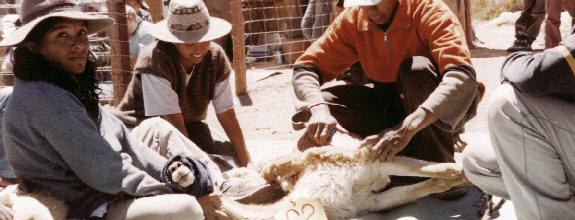|
Utilisation systems
The harvest of fibre from vicunas and guanacos is unique in
wild animal management in that shearing can be carried out without the need to
kill, as is the case with other fur and fibre bearing wild animals. Though this
is obviously advantageous for conservation objectives, the operation subjects
the animals to several potentially stressful operations. This has important
animal welfare implications, and it is important that the systems that are
widely adopted conform with internationally accepted standards.
This research aims to evaluate different management regimes
(quasi-natural and captive) and a control population (wild unmanaged) for
vicuña, to allow direct comparison and meaningful assessment of the practices
that impact positively or adversely on the effectiveness of the handling
techniques, the welfare of the animals involved, and the quality of the fibre
offered for sale. The approach at the heart of this work is a systems
development technique more commonly used in manufacturing. Hazard Analysis
Critical Control Point is an analysis tool to identify the weakest link in a
system, so that system improvements are made in a structured and integrated way.
HACCP formalises the approach to allow the main animal “crisis points” to be
identified, and remedial modifications made. In the past, research on optimal
handling systems for animals has been hindered by the lack of a technique to
record changes in blood chemistry, particularly of hormones indicative of
stress, at the precise times that the animal is being exposed to a stimulus,
without the need to restrain the animal. For this reason, results have usually
been open to the criticism that the blood-sampling procedure could be
responsible for as much stress as the stimulus being tested. WP1 includes
development of a new technology designed for investigating the stress responses
of farmed red deer to transport, to give a clear picture of real-time changes in
blood chemistry in unrestrained vicuna experiencing all the stages of a handling
procedure.
It is the first time that this technique has been applied
to free living wild animals, but it is expected to pave the way for many
similar studies in other species. The beauty of the system is that blood
samples can be taken by remote command at will, while behaviour is being
simultaneously recorded. Up to 32 samples may be taken before the cartridge of
flasks needs changing. This will enable the blood chemistry dynamics to be
accurately followed during the entire capture and release cycle. For animals to
be released into the wild, the monitoring apparatus can be set up to administer
a dose of anaesthetic, so that the device can be removed from the animal at the
end of the experiment. |
 |

Resources
Stress
Sustainable use
Sustainable use (2) |


